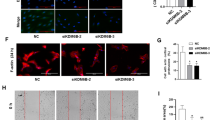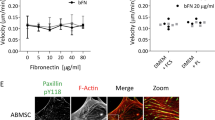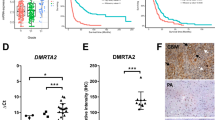Abstract
Matrix metalloproteinases (MMPs) are a family of proteinases known to have a role in cell migration. In the present study, we evaluated the role of MMP-2 on tropism of human umbilical cord blood-derived stem cells (hUCBSCs) in a human medulloblastoma tumor model. Consequences of MMP-2 inhibition on stem cell tropism towards medulloblastoma were studied in terms of stem cell migration by using cell culture inserts, transwell chamber assay, western blotting for MMP-2 and migratory molecules, and immunohistochemistry. Conditioned medium from Daoy/D283 cells infected with adenoviral vector encoding MMP-2 small interfering RNA (siRNA) (Ad-MMP-2 si)-reduced stem cell migration as compared with conditioned medium from mock and scrambled vector (Ad-SV) infected cells. In addition, MMP-2 inhibition in the tumor cells decreased the expression of stromal cell-derived factor 1 (SDF1) in the tumor-conditioned medium, which results in impaired SDF1/CXCR4 signaling leading to decreased stem cell tropism towards the tumor cells. We further show that MMP-2 inhibition in the tumor cells repressed stem cell tropism towards medulloblastoma tumors in vivo. In summary, we conclude that hUCBSCs can integrate into human medulloblastoma after local delivery and that MMP-2 expression by the tumor cells mediates this response through the SDF1/CXCR4 axis.
This is a preview of subscription content, access via your institution
Access options
Subscribe to this journal
Receive 12 print issues and online access
$259.00 per year
only $21.58 per issue
Buy this article
- Purchase on Springer Link
- Instant access to full article PDF
Prices may be subject to local taxes which are calculated during checkout






Similar content being viewed by others
Abbreviations
- Ad:
-
Adenoviral
- ECM:
-
extracellular matrix
- FITC:
-
fluorescein isothiocyanate
- GAPDH:
-
glyceraldehyde-3-phosphate dehydrogenase
- hUCBSCs:
-
Human umbilical cord blood stem cells
- H&E:
-
haematoxylin and eosin
- MMP-2:
-
matrix metalloproteinases 2
- PBS:
-
phosphate-buffered saline
- RIPA:
-
Radioimmunoprecipitation assay
- SV:
-
scrambled vector
- siRNA:
-
small interfering RNA
References
Benedetti S, Pirola B, Pollo B, Magrassi L, Bruzzone MG, Rigamonti D et al. Gene therapy of experimental brain tumors using neural progenitor cells. Nat Med 2000; 6: 447–450.
Aboody KS, Brown A, Rainov NG, Bower KA, Liu S, Yang W et al. Neural stem cells display extensive tropism for pathology in adult brain: evidence from intracranial gliomas. Proc Natl Acad Sci USA 2000; 97: 12846–12851.
Yip S, Aboody KS, Burns M, Imitola J, Boockvar JA, Allport J et al. Neural stem cell biology may be well suited for improving brain tumor therapies. Cancer J 2003; 9: 189–204.
Lee KH, Choi EY, Hyun MS, Kim JR . Involvement of MAPK pathway in hypoxia-induced up-regulation of urokinase plasminogen activator receptor in a human prostatic cancer cell line, PC3MLN4. Exp Mol Med 2004; 36: 57–64.
Gang EJ, Hong SH, Jeong JA, Hwang SH, Kim SW, Yang IH et al. In vitro mesengenic potential of human umbilical cord blood-derived mesenchymal stem cells. Biochem Biophys Res Commun 2004; 321: 102–108.
Yang SE, Ha CW, Jung M, Jin HJ, Lee M, Song H et al. Mesenchymal stem/progenitor cells developed in cultures from UC blood. Cytotherapy 2004; 6: 476–486.
Kim SM, Lim JY, Park SI, Jeong CH, Oh JH, Jeong M et al. Gene therapy using TRAIL-secreting human umbilical cord blood-derived mesenchymal stem cells against intracranial glioma. Cancer Res 2008; 68: 9614–9623.
Kollar K, Cook MM, Atkinson K, Brooke G . Molecular mechanisms involved in mesenchymal stem cell migration to the site of acute myocardial infarction. Int J Cell Biol 2009; E-pub ahead of print 12 July 2009; doi:10.1155/2009/904682.
Stamenkovic I . Extracellular matrix remodelling: the role of matrix metalloproteinases. J Pathol 2003; 200: 448–464.
Chang C, Werb Z . The many faces of metalloproteases: cell growth, invasion, angiogenesis and metastasis. Trends Cell Biol 2001; 11: S37–S43.
Mannello F, Tonti GA, Bagnara GP, Papa S . Role and function of matrix metalloproteinases in the differentiation and biological characterization of mesenchymal stem cells. Stem Cells 2006; 24: 475–481.
Karagiannis ED, Popel AS . Distinct modes of collagen type I proteolysis by matrix metalloproteinase (MMP) 2 and membrane type I MMP during the migration of a tip endothelial cell: insights from a computational model. J Theor Biol 2006; 238: 124–145.
Segarra M, Vilardell C, Matsumoto K, Esparza J, Lozano E, Serra-Pages C et al. Dual function of focal adhesion kinase in regulating integrin-induced MMP-2 and MMP-9 release by human T lymphoid cells. FASEB J 2005; 19: 1875–1877.
De Becker A, Van Hummelen P, Bakkus M, Vande Broek I, De Wever J, De Waele M et al. Migration of culture-expanded human mesenchymal stem cells through bone marrow endothelium is regulated by matrix metalloproteinase-2 and tissue inhibitor of metalloproteinase-3. Haematologica 2007; 92: 440–449.
Gondi CS, Veeravalli KK, Gorantla B, Dinh DH, Fassett D, Klopfenstein JD et al. Human umbilical cord blood stem cells show PDGF-D-dependent glioma cell tropism in vitro and in vivo. Neuro Oncol 2010; 12: 453–465.
Ozen O, Krebs B, Hemmerlein B, Pekrun A, Kretzschmar H, Herms J . Expression of matrix metalloproteinases and their inhibitors in medulloblastomas and their prognostic relevance. Clin Cancer Res 2004; 10: 4746–4753.
Chetty C, Bhoopathi P, Lakka SS, Rao JS . MMP-2 siRNA induced Fas/CD95-mediated extrinsic II apoptotic pathway in the A549 lung adenocarcinoma cell line. Oncogene 2007; 26: 7675–7683.
Bhoopathi P, Chetty C, Kunigal S, Vanamala SK, Rao JS, Lakka SS . Blockade of tumor growth due to matrix metalloproteinase-9 inhibition is mediated by sequential activation of beta1-integrin, ERK, and NF-kappaB. J Biol Chem 2008; 283: 1545–1552.
Kim SK, Kim SU, Park IH, Bang JH, Aboody KS, Wang KC et al. Human neural stem cells target experimental intracranial medulloblastoma and deliver a therapeutic gene leading to tumor regression. Clin Cancer Res 2006; 12: 5550–5556.
Kucia M, Reca R, Miekus K, Wanzeck J, Wojakowski W, Janowska-Wieczorek A et al. Trafficking of normal stem cells and metastasis of cancer stem cells involve similar mechanisms: pivotal role of the SDF-1-CXCR4 axis. Stem Cells 2005; 23: 879–894.
Rubin JB, Kung AL, Klein RS, Chan JA, Sun Y, Schmidt K et al. A small-molecule antagonist of CXCR4 inhibits intracranial growth of primary brain tumors. Proc Natl Acad Sci USA 2003; 100: 13513–13518.
Lazarini F, Tham TN, Casanova P, renzana-Seisdedos F, Dubois-Dalcq M . Role of the alpha-chemokine stromal cell-derived factor (SDF-1) in the developing and mature central nervous system. Glia 2003; 42: 139–148.
Reiss K, Mentlein R, Sievers J, Hartmann D . Stromal cell-derived factor 1 is secreted by meningeal cells and acts as chemotactic factor on neuronal stem cells of the cerebellar external granular layer. Neuroscience 2002; 115: 295–305.
Imitola J, Raddassi K, Park KI, Mueller FJ, Nieto M, Teng YD et al. Directed migration of neural stem cells to sites of CNS injury by the stromal cell-derived factor 1alpha/CXC chemokine receptor 4 pathway. Proc Natl Acad Sci USA 2004; 101: 18117–18122.
Dao MA, Creer MH, Nolta JA, Verfaillie CM . Biology of umbilical cord blood progenitors in bone marrow niches. Blood 2007; 110: 74–81.
Erlandsson A, Larsson J, Forsberg-Nilsson K . Stem cell factor is a chemoattractant and a survival factor for CNS stem cells. Exp Cell Res 2004; 301: 201–210.
Guo Y, Hangoc G, Bian H, Pelus LM, Broxmeyer HE . SDF-1/CXCL12 enhances survival and chemotaxis of murine embryonic stem cells and production of primitive and definitive hematopoietic progenitor cells. Stem Cells 2005; 23: 1324–1332.
Rosu-Myles M, Gallacher L, Murdoch B, Hess DA, Keeney M, Kelvin D et al. The human hematopoietic stem cell compartment is heterogeneous for CXCR4 expression. Proc Natl Acad Sci USA 2000; 97: 14626–14631.
Wynn RF, Hart CA, Corradi-Perini C, O’Neill L, Evans CA, Wraith JE et al. A small proportion of mesenchymal stem cells strongly expresses functionally active CXCR4 receptor capable of promoting migration to bone marrow. Blood 2004; 104: 2643–2645.
Sordi V, Malosio ML, Marchesi F, Mercalli A, Melzi R, Giordano T et al. Bone marrow mesenchymal stem cells express a restricted set of functionally active chemokine receptors capable of promoting migration to pancreatic islets. Blood 2005; 106: 419–427.
Chetty C, Bhoopathi P, Joseph P, Chittivelu S, Rao JS, Lakka SS . Adenovirus-mediated siRNA against MMP-2 suppresses tumor growth and lung metastasis in mice. Mol Cancer Ther 2006; 5: 2289–2299.
Lee IO, Kim JH, Choi YJ, Pillinger MH, Kim SY, Blaser MJ et al. Helicobacter pylori CagA phosphorylation status determines the gp130-activated SHP2/ERK and JAK/STAT signal transduction pathways in gastric epithelial cells. J Biol Chem 2010; 285: 16042–16050.
Bhoopathi P, Chetty C, Gujrati M, Dinh DH, Rao JS, Lakka SS . The role of MMP-9 in the anti-angiogenic effect of secreted protein acidic and rich in cysteine. Br J Cancer 2010; 102: 530–540.
Chomczynski P, Sacchi N . Single-step method of RNA isolation by acid guanidinium thiocyanate-phenol-chloroform extraction. Anal Biochem 1987; 162: 156–159.
Workman P, Balmain A, Hickman JA, McNally NJ, Rohas AM, Mitchison NA et al. UKCCCR guidelines for the welfare of animals in experimental neoplasia. Lab Anim 1988; 22: 195–201.
Shu Q, Antalffy B, Su JM, Adesina A, Ou CN, Pietsch T et al. Valproic acid prolongs survival time of severe combined immunodeficient mice bearing intracerebellar orthotopic medulloblastoma xenografts. Clin Cancer Res 2006; 12: 4687–4694.
Acknowledgements
We acknowledge Shellee Abraham for manuscript preparation, Sushma Jasti and Diana Meister for manuscript review. This research was supported by National Cancer Institute Grant CA132853 (to SL). Contents of this paper are solely the responsibility of the authors and do not necessarily represent the official views of NIH.
Author information
Authors and Affiliations
Corresponding author
Ethics declarations
Competing interests
The authors declare no conflict of interest.
Additional information
Supplementary Information accompanies the paper on Gene Therapy website
Supplementary information
Rights and permissions
About this article
Cite this article
Bhoopathi, P., Chetty, C., Gogineni, V. et al. MMP-2 mediates mesenchymal stem cell tropism towards medulloblastoma tumors. Gene Ther 18, 692–701 (2011). https://doi.org/10.1038/gt.2011.14
Received:
Revised:
Accepted:
Published:
Issue Date:
DOI: https://doi.org/10.1038/gt.2011.14
Keywords
This article is cited by
-
Endothelial cell-derived MMP19 promotes pulmonary fibrosis by inducing E(nd)MT and monocyte infiltration
Cell Communication and Signaling (2023)
-
SH3RF3 promotes breast cancer stem-like properties via JNK activation and PTX3 upregulation
Nature Communications (2020)
-
Transplantation of human bone marrow mesenchymal stromal cells reduces liver fibrosis more effectively than Wharton’s jelly mesenchymal stromal cells
Stem Cell Research & Therapy (2017)
-
ERK signaling is required for VEGF-A/VEGFR2-induced differentiation of porcine adipose-derived mesenchymal stem cells into endothelial cells
Stem Cell Research & Therapy (2017)
-
Identification of new genes associated to senescent and tumorigenic phenotypes in mesenchymal stem cells
Scientific Reports (2017)



